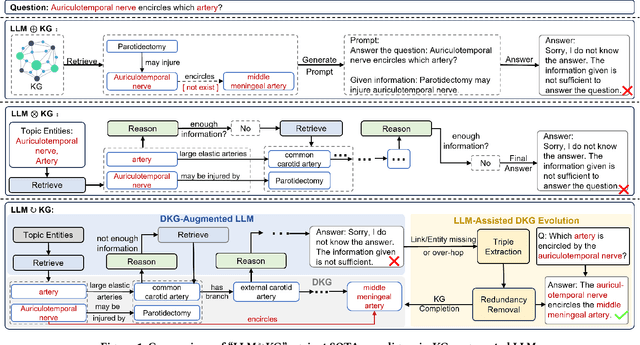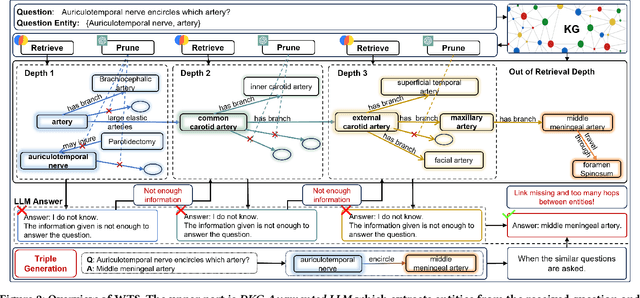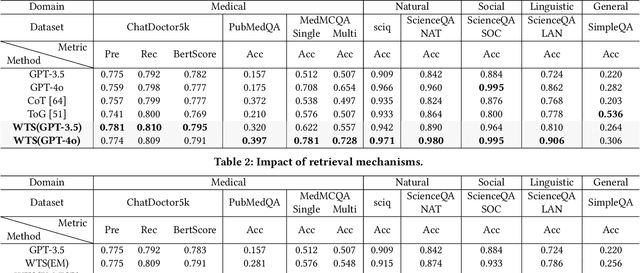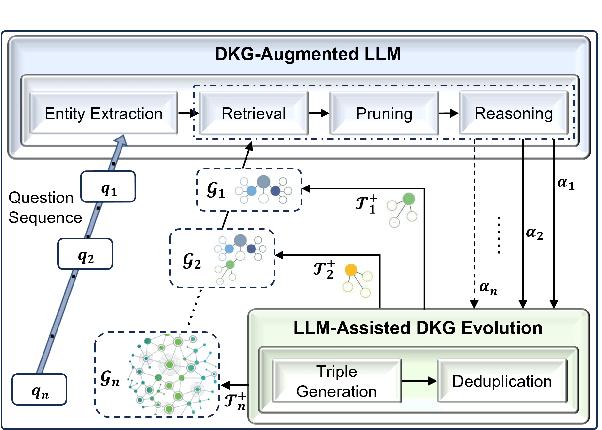Yutong Zhang
Generative Interfaces for Language Models
Aug 26, 2025Abstract:Large language models (LLMs) are increasingly seen as assistants, copilots, and consultants, capable of supporting a wide range of tasks through natural conversation. However, most systems remain constrained by a linear request-response format that often makes interactions inefficient in multi-turn, information-dense, and exploratory tasks. To address these limitations, we propose Generative Interfaces for Language Models, a paradigm in which LLMs respond to user queries by proactively generating user interfaces (UIs) that enable more adaptive and interactive engagement. Our framework leverages structured interface-specific representations and iterative refinements to translate user queries into task-specific UIs. For systematic evaluation, we introduce a multidimensional assessment framework that compares generative interfaces with traditional chat-based ones across diverse tasks, interaction patterns, and query types, capturing functional, interactive, and emotional aspects of user experience. Results show that generative interfaces consistently outperform conversational ones, with humans preferring them in over 70% of cases. These findings clarify when and why users favor generative interfaces, paving the way for future advancements in human-AI interaction.
Evo-MARL: Co-Evolutionary Multi-Agent Reinforcement Learning for Internalized Safety
Aug 05, 2025


Abstract:Multi-agent systems (MAS) built on multimodal large language models exhibit strong collaboration and performance. However, their growing openness and interaction complexity pose serious risks, notably jailbreak and adversarial attacks. Existing defenses typically rely on external guard modules, such as dedicated safety agents, to handle unsafe behaviors. Unfortunately, this paradigm faces two challenges: (1) standalone agents offer limited protection, and (2) their independence leads to single-point failure-if compromised, system-wide safety collapses. Naively increasing the number of guard agents further raises cost and complexity. To address these challenges, we propose Evo-MARL, a novel multi-agent reinforcement learning (MARL) framework that enables all task agents to jointly acquire defensive capabilities. Rather than relying on external safety modules, Evo-MARL trains each agent to simultaneously perform its primary function and resist adversarial threats, ensuring robustness without increasing system overhead or single-node failure. Furthermore, Evo-MARL integrates evolutionary search with parameter-sharing reinforcement learning to co-evolve attackers and defenders. This adversarial training paradigm internalizes safety mechanisms and continually enhances MAS performance under co-evolving threats. Experiments show that Evo-MARL reduces attack success rates by up to 22% while boosting accuracy by up to 5% on reasoning tasks-demonstrating that safety and utility can be jointly improved.
Kimi K2: Open Agentic Intelligence
Jul 28, 2025Abstract:We introduce Kimi K2, a Mixture-of-Experts (MoE) large language model with 32 billion activated parameters and 1 trillion total parameters. We propose the MuonClip optimizer, which improves upon Muon with a novel QK-clip technique to address training instability while enjoying the advanced token efficiency of Muon. Based on MuonClip, K2 was pre-trained on 15.5 trillion tokens with zero loss spike. During post-training, K2 undergoes a multi-stage post-training process, highlighted by a large-scale agentic data synthesis pipeline and a joint reinforcement learning (RL) stage, where the model improves its capabilities through interactions with real and synthetic environments. Kimi K2 achieves state-of-the-art performance among open-source non-thinking models, with strengths in agentic capabilities. Notably, K2 obtains 66.1 on Tau2-Bench, 76.5 on ACEBench (En), 65.8 on SWE-Bench Verified, and 47.3 on SWE-Bench Multilingual -- surpassing most open and closed-sourced baselines in non-thinking settings. It also exhibits strong capabilities in coding, mathematics, and reasoning tasks, with a score of 53.7 on LiveCodeBench v6, 49.5 on AIME 2025, 75.1 on GPQA-Diamond, and 27.1 on OJBench, all without extended thinking. These results position Kimi K2 as one of the most capable open-source large language models to date, particularly in software engineering and agentic tasks. We release our base and post-trained model checkpoints to facilitate future research and applications of agentic intelligence.
MorphIt: Flexible Spherical Approximation of Robot Morphology for Representation-driven Adaptation
Jul 18, 2025



Abstract:What if a robot could rethink its own morphological representation to better meet the demands of diverse tasks? Most robotic systems today treat their physical form as a fixed constraint rather than an adaptive resource, forcing the same rigid geometric representation to serve applications with vastly different computational and precision requirements. We introduce MorphIt, a novel algorithm for approximating robot morphology using spherical primitives that balances geometric accuracy with computational efficiency. Unlike existing approaches that rely on either labor-intensive manual specification or inflexible computational methods, MorphIt implements an automatic gradient-based optimization framework with tunable parameters that provides explicit control over the physical fidelity versus computational cost tradeoff. Quantitative evaluations demonstrate that MorphIt outperforms baseline approaches (Variational Sphere Set Approximation and Adaptive Medial-Axis Approximation) across multiple metrics, achieving better mesh approximation with fewer spheres and reduced computational overhead. Our experiments show enhanced robot capabilities in collision detection accuracy, contact-rich interaction simulation, and navigation through confined spaces. By dynamically adapting geometric representations to task requirements, robots can now exploit their physical embodiment as an active resource rather than an inflexible parameter, opening new frontiers for manipulation in environments where physical form must continuously balance precision with computational tractability.
TrajFlow: Multi-modal Motion Prediction via Flow Matching
Jun 10, 2025Abstract:Efficient and accurate motion prediction is crucial for ensuring safety and informed decision-making in autonomous driving, particularly under dynamic real-world conditions that necessitate multi-modal forecasts. We introduce TrajFlow, a novel flow matching-based motion prediction framework that addresses the scalability and efficiency challenges of existing generative trajectory prediction methods. Unlike conventional generative approaches that employ i.i.d. sampling and require multiple inference passes to capture diverse outcomes, TrajFlow predicts multiple plausible future trajectories in a single pass, significantly reducing computational overhead while maintaining coherence across predictions. Moreover, we propose a ranking loss based on the Plackett-Luce distribution to improve uncertainty estimation of predicted trajectories. Additionally, we design a self-conditioning training technique that reuses the model's own predictions to construct noisy inputs during a second forward pass, thereby improving generalization and accelerating inference. Extensive experiments on the large-scale Waymo Open Motion Dataset (WOMD) demonstrate that TrajFlow achieves state-of-the-art performance across various key metrics, underscoring its effectiveness for safety-critical autonomous driving applications. The code and other details are available on the project website https://traj-flow.github.io/.
Unfettered Forceful Skill Acquisition with Physical Reasoning and Coordinate Frame Labeling
May 14, 2025Abstract:Vision language models (VLMs) exhibit vast knowledge of the physical world, including intuition of physical and spatial properties, affordances, and motion. With fine-tuning, VLMs can also natively produce robot trajectories. We demonstrate that eliciting wrenches, not trajectories, allows VLMs to explicitly reason about forces and leads to zero-shot generalization in a series of manipulation tasks without pretraining. We achieve this by overlaying a consistent visual representation of relevant coordinate frames on robot-attached camera images to augment our query. First, we show how this addition enables a versatile motion control framework evaluated across four tasks (opening and closing a lid, pushing a cup or chair) spanning prismatic and rotational motion, an order of force and position magnitude, different camera perspectives, annotation schemes, and two robot platforms over 220 experiments, resulting in 51% success across the four tasks. Then, we demonstrate that the proposed framework enables VLMs to continually reason about interaction feedback to recover from task failure or incompletion, with and without human supervision. Finally, we observe that prompting schemes with visual annotation and embodied reasoning can bypass VLM safeguards. We characterize prompt component contribution to harmful behavior elicitation and discuss its implications for developing embodied reasoning. Our code, videos, and data are available at: https://scalingforce.github.io/.
Kimi-Audio Technical Report
Apr 25, 2025Abstract:We present Kimi-Audio, an open-source audio foundation model that excels in audio understanding, generation, and conversation. We detail the practices in building Kimi-Audio, including model architecture, data curation, training recipe, inference deployment, and evaluation. Specifically, we leverage a 12.5Hz audio tokenizer, design a novel LLM-based architecture with continuous features as input and discrete tokens as output, and develop a chunk-wise streaming detokenizer based on flow matching. We curate a pre-training dataset that consists of more than 13 million hours of audio data covering a wide range of modalities including speech, sound, and music, and build a pipeline to construct high-quality and diverse post-training data. Initialized from a pre-trained LLM, Kimi-Audio is continual pre-trained on both audio and text data with several carefully designed tasks, and then fine-tuned to support a diverse of audio-related tasks. Extensive evaluation shows that Kimi-Audio achieves state-of-the-art performance on a range of audio benchmarks including speech recognition, audio understanding, audio question answering, and speech conversation. We release the codes, model checkpoints, as well as the evaluation toolkits in https://github.com/MoonshotAI/Kimi-Audio.
Transforming Vision Transformer: Towards Efficient Multi-Task Asynchronous Learning
Jan 12, 2025



Abstract:Multi-Task Learning (MTL) for Vision Transformer aims at enhancing the model capability by tackling multiple tasks simultaneously. Most recent works have predominantly focused on designing Mixture-of-Experts (MoE) structures and in tegrating Low-Rank Adaptation (LoRA) to efficiently perform multi-task learning. However, their rigid combination hampers both the optimization of MoE and the ef fectiveness of reparameterization of LoRA, leading to sub-optimal performance and low inference speed. In this work, we propose a novel approach dubbed Efficient Multi-Task Learning (EMTAL) by transforming a pre-trained Vision Transformer into an efficient multi-task learner during training, and reparameterizing the learned structure for efficient inference. Specifically, we firstly develop the MoEfied LoRA structure, which decomposes the pre-trained Transformer into a low-rank MoE structure and employ LoRA to fine-tune the parameters. Subsequently, we take into account the intrinsic asynchronous nature of multi-task learning and devise a learning Quality Retaining (QR) optimization mechanism, by leveraging the historical high-quality class logits to prevent a well-trained task from performance degradation. Finally, we design a router fading strategy to integrate the learned parameters into the original Transformer, archiving efficient inference. Extensive experiments on public benchmarks demonstrate the superiority of our method, compared to the state-of-the-art multi-task learning approaches.
A Machine Learning Approach to Contact Localization in Variable Density Three-Dimensional Tactile Artificial Skin
Dec 01, 2024



Abstract:Estimating the location of contact is a primary function of artificial tactile sensing apparatuses that perceive the environment through touch. Existing contact localization methods use flat geometry and uniform sensor distributions as a simplifying assumption, limiting their ability to be used on 3D surfaces with variable density sensing arrays. This paper studies contact localization on an artificial skin embedded with mutual capacitance tactile sensors, arranged non-uniformly in an unknown distribution along a semi-conical 3D geometry. A fully connected neural network is trained to localize the touching points on the embedded tactile sensors. The studied online model achieves a localization error of $5.7 \pm 3.0$ mm. This research contributes a versatile tool and robust solution for contact localization that is ambiguous in shape and internal sensor distribution.
Way to Specialist: Closing Loop Between Specialized LLM and Evolving Domain Knowledge Graph
Nov 28, 2024



Abstract:Large language models (LLMs) have demonstrated exceptional performance across a wide variety of domains. Nonetheless, generalist LLMs continue to fall short in reasoning tasks necessitating specialized knowledge. Prior investigations into specialized LLMs focused on domain-specific training, which entails substantial efforts in domain data acquisition and model parameter fine-tuning. To address these challenges, this paper proposes the Way-to-Specialist (WTS) framework, which synergizes retrieval-augmented generation with knowledge graphs (KGs) to enhance the specialized capability of LLMs in the absence of specialized training. In distinction to existing paradigms that merely utilize external knowledge from general KGs or static domain KGs to prompt LLM for enhanced domain-specific reasoning, WTS proposes an innovative "LLM$\circlearrowright$KG" paradigm, which achieves bidirectional enhancement between specialized LLM and domain knowledge graph (DKG). The proposed paradigm encompasses two closely coupled components: the DKG-Augmented LLM and the LLM-Assisted DKG Evolution. The former retrieves question-relevant domain knowledge from DKG and uses it to prompt LLM to enhance the reasoning capability for domain-specific tasks; the latter leverages LLM to generate new domain knowledge from processed tasks and use it to evolve DKG. WTS closes the loop between DKG-Augmented LLM and LLM-Assisted DKG Evolution, enabling continuous improvement in the domain specialization as it progressively answers and learns from domain-specific questions. We validate the performance of WTS on 6 datasets spanning 5 domains. The experimental results show that WTS surpasses the previous SOTA in 4 specialized domains and achieves a maximum performance improvement of 11.3%.
 Add to Chrome
Add to Chrome Add to Firefox
Add to Firefox Add to Edge
Add to Edge